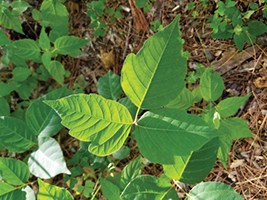By Nadie VanZandt
In summer, while vegetables and flowers thrive in the garden, so does poison ivy in backyards, woods, disturbed areas and anywhere else it can get a toehold. Challenging to recognize due to its changing shape in different environments, careful observation and some knowledge of poison ivy could help you avoid a nasty rash.
Poison ivy belongs to the diverse Anacardiaceae family known for plants that produce a highly toxic resin. Anacardiaceae consists of over 70 genera and over 800 species of trees and shrubs including sumac, cashew, pistachio, mango, Chinese lacquer tree and poison oak.
This North American native has an interesting history. In 1624, explorer John Smith described it as resembling English ivy and causing redness, itching and blisters.
As an exotic plant, it was exported to Europe for cultivation in royal gardens, notably flourishing in those of Empress Joséphine Bonaparte.
During the 18th century, medical practitioners, intrigued by its adverse effect on the body, used it in misguided medical experiments.
In the 1920s, Riko Majima, a Japanese chemist study- ing the sap of the lacquer tree (Toxicodendron vernicifluum), isolated the toxic compound and determined its chemical composition. He named it urushiol after urushi, meaning lacquer in Japanese. The Latin word Toxicodendron denotes the genus of the poisonous plants in this family.
Urushiol, found in all parts of the plant, is an oily resin that sticks to surfaces and easily penetrates the skin. It causes mild to severe cases of dermatitis in humans from reddening and itching to extensive swelling and oozing blisters. Burning the plant causes urushiol to volatilize in smoke which, when inhaled, can lead to a serious adverse reaction and even death.
People highly allergic to urushiol also may react to fruit and nuts of the Anacardiaceae family. Urushiol, present in the skin of mangoes, can cause a blister rash on the lips.
Identifying and avoiding contact with poison ivy is the only way to prevent the rash. However, urushiol contamination from garden tools, and even family pets, is a valid concern.
Both species of poison ivy, Toxicodendron radicans (a woody perennial shrub or vine) and Toxicodendron Rydbergii (a woody shrub or groundcover) thrive in Vermont. They grow best in full sun and moist, fertile soils but tolerate shade and adapt to a wide variety of conditions.
You can identify poison ivy by its alternate compound leaf with three leaflets. The central leaflet has a longer petiolule (stem at the base of a leaflet) than the lateral leaflets. The leaflet’s edge may or may not have lobes or notches but is not serrated. In addition, stems of poison ivy have no spines or thorns.
Wild raspberries and blackberries often are mistaken for poison ivy because they also have “leaves of three.” The leaves of these bushes have serrated or saw-toothed edges, and their stems have thorns.
Poison ivy vines use aerial roots to cling to a host. They don’t use twining petioles to climb. Their deep and fibrous roots grow from creeping underground rhizomes that can be found on the surface or 6 inches deep in the soil.
In June and July, poison ivy has flowers with five petals that grow in loose clusters. In September, it produces small round green drupes (fleshy fruit with a central stone containing the seed) in grape-like clusters. As a native plant, it provides a food source for many birds, small mammals and even livestock.
Although poison ivy is neither on Vermont’s official list of invasive species nor classified as a noxious weed, it is both. So the best advice is to heed the words of the familiar adage, “Leaves of Three, Leave it Be.”
For more information on poison ivy and its control, consult the guidelines online at bit.ly/3xoWraB.
Nadie VanZandt is a UVM Extension Master Gardener from Panton.




